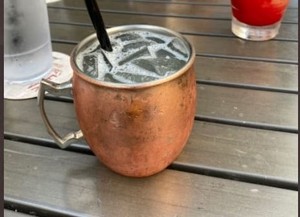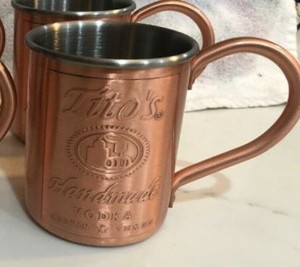(Because we know that man does not live by politics alone, but also by film, sports, booze, and barbecue, RedState writers are expanding their base of topics covered. “Dipsology: Beyond the Basics” is part of that effort as a RedState VIP exclusive. Click here to become a RedState VIP member and use code SLAGER for a sweet discount!)
Despite its namesake make no mistake — we are talking about a purely American concoction. Made iconic by its signature drinkware, the Moscow Mule — usually vodka, ginger beer, lime, and mint — has seen a unique level of resurgence over the past decade. It seemed like for no firm reason the drink was suddenly a fixture in many bars and restaurants, with copper mugs prevalent, variations being offered, and many adopting the cocktail as their signature drink of choice. While this newfound surge is a little mysterious the popularity is not.
It is easily seen why the Mule (technically a Buck) is so welcomed. It is an invigorating sipper, with a tart herbal flavor and an adaptable strength, based on your preference. The copper vessel adds to the sensory enjoyment, and overall it makes for a great summertime selection. While enthusiasm for this one is high, what many might be surprised to hear is this is a drink generations in the works, and, as usual, we see it has a provenance that is rather tough to pin down.

Pick Your Coast and Your Cast
There are a variety of stories surrounding the creation of this potable, with about the only agreement being the early 1940s was the emergence. While these are fanciful and share a common thread of being born out of necessity, one thing that seems apparent is the drink appears as a variant, not a wholly concocted original. The Buck is a long-recognized cocktail of 3 simple ingredients; ginger beer, lemon or lime juice, and a spirit of choice. Originating as what was called The Horse’s Neck — simply the ginger beer and juice — the addition of liquor would give the drink a kick, hence the Buck. It is easy to see then that “Mule” could derive here, possibly as it is alliterative with the vodka/Moscow name.
There are common names and common motivations attached to the formation, the interesting side note is that while its birth may have been on opposite sides of the map it is said to involve the same actors in either case. Two men with product to move are said to have teamed up for the alchemy to take place.
In one scenario, Jack Morgan was a restauranteur who had created his own ginger beer that he was starting to sell across the country. In New York, he sat with a longtime friend, John Martin, the head of a liquor distributorship out of Massachusetts, who had recently acquired the Smirnoff distillery. With both men looking to move their wares, they hatched a way to combine their products in order to garner interest. The initial version of the Moscow Mule was put together and soon became popular with the Broadway crowd and became a hit.
OR, it another version has a similar pattern of events occurring but in the Los Angeles area, where Morgan owned a restaurant. Either they worked out the recipe, or – well, there’s yet another version, which has Morgan’s bartender coming up with the concoction as he was looking to move stock from their basement that was not selling. But, following its creation, actor Broderick Crawford allegedly took a shine to the drink, soon launching its popularity.
Then there is more gauzy history, this time involving the famed cup.
Copper-tunity
One story on the origin of the metal mugs is so fanciful that it just sounds apocryphal. In the 1930s a Russian immigrant by the name of Sophie Berezinski had been working in her family’s Moscow metal works creating mugs made of copper. As hard times hit their country she made off for America, with a passel of her creations. Here is where the challenge comes into play, as she is said to have traveled with 2,000 of the mugs.
After a time spent in New York, she then struck out for Los Angeles, again with 2K of her unsold cups in tow. It was there that she encountered the pair of liquid barons, and combined the three who were all desperate to move their laden stocks hatched the new cocktail. This seems a bit too convenient, and it does not explain how a Russian emigre managed to find her way into a relationship with longtime friends.
Another variation from historian Ted Haigh has the more plausible explanation — Morgan’s girlfriend, Osalene Schmitt, inherited a copper manufacturing company and this was the source of the drinkware. Her involvement seems more plausible, as the popularity of the cups and the drink were both rocketing skyward. Martin is said to have traveled with the mugs from bar to bar, offering them up to the bartenders, and taking 2 Polaroid pics of them posing with the copper vessel. One photo was left with the hooch-slinger, and Martin built up a catalog of photos to show to the others, creating a desire for the mugs and hence the spread of the drink’s popularity. It is doubtful Sophie’s stock would have fed this enterprise for very long.

Mixing The Mule For a Kick
Much like the unsettled history, the recipe for the Moscow Mule is also a bit, um, fluid. While lemon juice was the original ingredient that has segued over to lime, lending more complexity to tie in with the spice of the ginger beer. In the last generation, mint has also become a featured component, and this only lends more to the complexity of the drink. What also adds to the appeal is that rather than a quaint addition, the garnishes are used liberally. 2-3 wedges of limes are common, plenty of mint leaves are involved, or a whole sprig and even the measurements are free to adjustment.
My preference is to go with a larger mug, at least in the 16oz range, to give you flexibility. But here is a good baseline to start, and then experiment with your preferred flavor adjustments.
MOSCOW MULE
- 2oz. Vodka
- 3oz. Ginger Beer
- 1/2 oz. Fresh Lime Juice
- 4-6 Mint leaves
- In shaker with crushed ice add vodka, lime juice, a wedge of lime, and mint leaves. Shake well and pour into a copper mug. Add Ginger Beer (to preserve carbonation) and stir. Garnish with Lime wedge and mint sprig.
Do not worry at all about collusion, as this is a purely American cocktail, but if you feel the need to remain patriotic you can always opt for quality vodka made in the states, such as Tito’s, Skyy, Deep Eddy, and many others made domestically.














